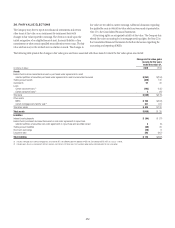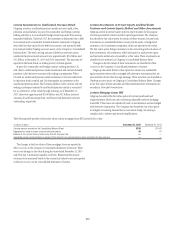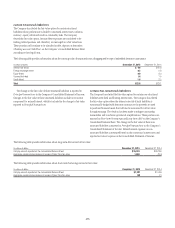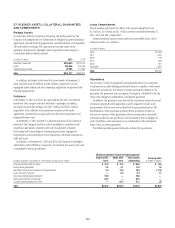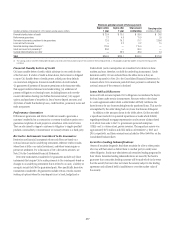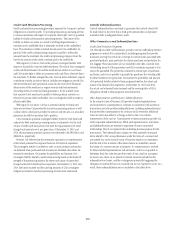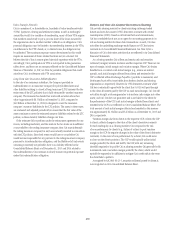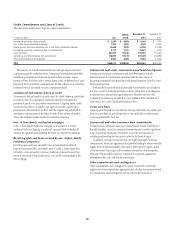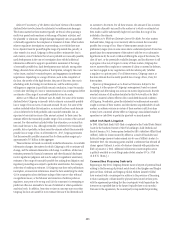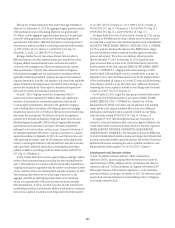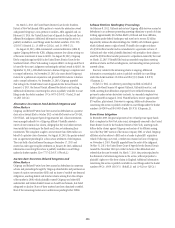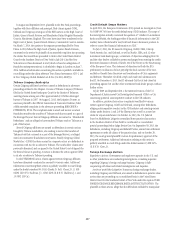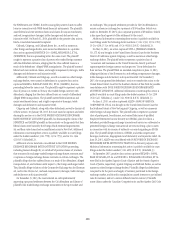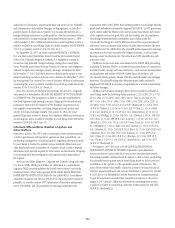Citibank 2015 Annual Report Download - page 297
Download and view the complete annual report
Please find page 297 of the 2015 Citibank annual report below. You can navigate through the pages in the report by either clicking on the pages listed below, or by using the keyword search tool below to find specific information within the annual report.279
Value-Transfer Networks
Citi is a member of, or shareholder in, hundreds of value-transfer networks
(VTNs) (payment, clearing and settlement systems as well as exchanges)
around the world. As a condition of membership, many of these VTNs require
that members stand ready to pay a pro rata share of the losses incurred by
the organization due to another member’s default on its obligations. Citi’s
potential obligations may be limited to its membership interests in the VTNs,
contributions to the VTN’s funds, or, in limited cases, the obligation may
be unlimited. The maximum exposure cannot be estimated as this would
require an assessment of future claims that have not yet occurred. Citi
believes the risk of loss is remote given historical experience with the VTNs.
Accordingly, Citi’s participation in VTNs is not reported in the guarantees
tables above, and there are no amounts reflected on the Consolidated Balance
Sheet as of December 31, 2015 or 2014 for potential obligations that could
arise from Citi’s involvement with VTN associations.
Long-Term Care Insurance Indemnification
In the sale of an insurance subsidiary, the Company provided an
indemnification to an insurance company for policyholder claims and
other liabilities relating to a book of long-term care (LTC) business (for the
entire term of the LTC policies) that is fully reinsured by another insurance
company. The reinsurer has funded two trusts with securities whose fair
value (approximately $6.3 billion at December 31, 2015, compared to
$6.2 billion at December 31, 2014) is designed to cover the insurance
company’s statutory liabilities for the LTC policies. The assets in these trusts
are evaluated and adjusted periodically to ensure that the fair value of the
assets continues to cover the estimated statutory liabilities related to the LTC
policies, as those statutory liabilities change over time.
If the reinsurer fails to perform under the reinsurance agreement for any
reason, including insolvency, and the assets in the two trusts are insufficient
or unavailable to the ceding insurance company, then Citi must indemnify
the ceding insurance company for any losses actually incurred in connection
with the LTC policies. Since both events would have to occur before Citi
would become responsible for any payment to the ceding insurance company
pursuant to its indemnification obligation, and the likelihood of such events
occurring is currently not probable, there is no liability reflected in the
Consolidated Balance Sheet as of December 31, 2015 and 2014 related to
this indemnification. Citi continues to closely monitor its potential exposure
under this indemnification obligation.
Futures and Over-the-Counter Derivatives Clearing
Citi provides clearing services for clients executing exchange-traded
futures and over-the-counter (OTC) derivatives contracts with central
counterparties (CCPs). Based on all relevant facts and circumstances,
Citi has concluded that it acts as an agent for accounting purposes in its
role as clearing member for these client transactions. As such, Citi does
not reflect the underlying exchange-traded futures or OTC derivatives
contracts in its Consolidated Financial Statements. See Note 23 for a
discussion of Citi’s derivatives activities that are reflected in its Consolidated
Financial Statements.
As a clearing member, Citi collects and remits cash and securities
collateral (margin) between its clients and the respective CCP. There are two
types of margin: initial margin and variation margin. Where Citi obtains
benefits from or controls cash initial margin (e.g., retains an interest
spread), cash initial margin collected from clients and remitted to the
CCP is reflected within Brokerage Payables (payables to customers) and
Brokerage Receivables (receivables from brokers, dealers and clearing
organizations), respectively. However, for OTC derivatives contracts where
Citi has contractually agreed with the client that (i) Citi will pass through
to the client all interest paid by the CCP on cash initial margin; (ii) Citi will
not utilize its right as clearing member to transform cash margin into other
assets; and (iii) Citi does not guarantee and is not liable to the client for
the performance of the CCP, cash initial margin collected from clients and
remitted to the CCP is not reflected on Citi’s Consolidated Balance Sheet. The
total amount of cash initial margin collected and remitted in this manner
was approximately $4.3 billion and $3.2 billion as of December 31, 2015 and
2014, respectively.
Variation margin due from clients to the respective CCP, or from the CCP
to clients, reflects changes in the value of the client’s derivative contracts
for each trading day. As a clearing member, Citi is exposed to the risk
of non-performance by clients (e.g., failure of a client to post variation
margin to the CCP for negative changes in the value of the client’s derivative
contracts). In the event of non-performance by a client, Citi would move
to close out the client’s positions. The CCP would typically utilize initial
margin posted by the client and held by the CCP, with any remaining
shortfalls required to be paid by Citi as clearing member. Citi generally holds
incremental cash or securities margin posted by the client, which would
typically be expected to be sufficient to mitigate Citi’s credit risk in the event
the client fails to perform.
As required by ASC 860-30-25-5, securities collateral posted by clients is
not recognized on Citi’s Consolidated Balance Sheet.





